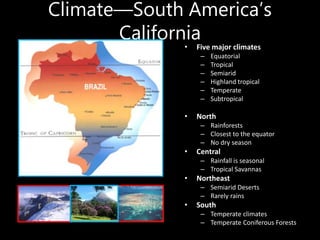brazil_geography.pptx
- 2. Location âĒ Located in South America âĒ On the equator âĒ Includes most of the continentâs interior âĒ Shares a border with all but two countries in South America âĒ Uruguay, Argentina, Paraguay, Bolivia, Peru, Colombia, Venezuela, Suriname, Guyana, French Guiana
- 3. Size âĒ Largest country in South America â Around half of the entire continent âĒ Fourth largest country in the world by size âĒ 3,286,488 Sq. Miles
- 4. ClimateâSouth Americaâs California âĒ Five major climates â Equatorial â Tropical â Semiarid â Highland tropical â Temperate â Subtropical âĒ North â Rainforests â Closest to the equator â No dry season âĒ Central â Rainfall is seasonal â Tropical Savannas âĒ Northeast â Semiarid Deserts â Rarely rains âĒ South â Temperate climates â Temperate Coniferous Forests
- 5. Biodiversity âĒ Greatest biodiversity in the world âĒ The Amazon Rainforestâ 1/10th of all species in the world âĒ Almost four million total types of plants and animal species âĒ Types of animals: maned wolf, bush dog, hoary foxes, jaguars, pumas, anteaters, sloths, anacondas, poison dart frogs, pink dolphins, penguins, Goliath Bird Eating Spiders
- 6. Natural Resources â A Competitive Advantage Water âĒ Brazil has 25% of the worlds fresh water Oil âĒ Big discoveries have led to a ton of investment âĒ âBy 2020, if all goes to plan, Petrobras and its foreign partners will be producing 5.7m barrels of oil and gas per day, more than half the output of Saudi Arabiaâ. (Economist, 2009) Minerals âĒ Iron Ore and Gold are most significant in terms of value of output âĒ Copper, Zinc, Bauxite, Manganese also important
- 7. Environmental Issues â Rhetoric vs. Practice Deforestation remains a major concern âĒ Deforestation of protected zones up 127% since 2000 âĒ Increased number of endangered species âĒ Belo Monte dam controversy Rapid Industrialization has resulted in more pollution âĒ 40% of fuel is ethanol based â different type of pollution âĒ Government has the goal to reduce greenhouse gas emissions by 38.9% by 2020 âĒ New policies to prevent deforestation are working Positive Negative
- 8. Racial CompositionâA Story of Diversity Aboriginal Brazilians (0.4%) Found in the entire territory of Brazil, but most live on Indian reservations in the North and Centre-West Over 60 Million Brazilians possess 1+ Amerindian ancestors, but consider âIndianâ cultural, not racial Black Brazilians (7.4%) Asian Brazilians (1.1%) Largest population of Japanese decent outside of Japan Pardo Brazilians/multiracial (42.6%) According to DNA resources, most Brazilians possess a mixed rate ancestry, but less than 45% identify as Pardo White Brazilians (51.7%) Soley descended from European immigrants, concentrated in the south and southeast regions
- 9. ReligionâUnique Perspective Roman Catholicism (68%) âĒ Largest # of Roman Catholics in the world âĒ Full of popular festivities influenced by popular Portuguese traditions No religious affiliation (15.4%) Protestantism (12.4%) Spiritism (3.3%) âĒ Afro-Brazilian religions, are concentrated in the Northeast large urban centers Other religions (1.7%) âĒ Many African, Spiritualist, and Folk religions incorporate original indigenous tradition âĒ Buddhism is the largest of all minority religions because of Brazilâs large Japanese Brazilian community
- 10. Portuguese Languageâ Fostering National Unity âĒ 11 dialects of Portuguese âĒ Influenced by Amerindian and African languages, creating differences between Portuguese spoken in Brazil and that of other Portuguese speaking countries âĒ This divide was heightened by introduction of words for technological innovations âĒ 210 minority languages are spoken in Brazil, including indigenous languages (80) and languages of more recent European and Asian immigrants
- 11. Regions/Largest Cities Regions: 1. Central-West: Home to the capital, Brasilia; otherwise low density 2. Northeast: Lowest living standards in Brazil; beautiful beaches, nonetheless 3. North: Home to the Amazon River and Rainforest 4. Southeast: Largest share of Brazilâs population with Sao Paulo and Rio de Janeiro 5. Southern: As densely populated as the Southeast, however mostly along the cost Largest cities: 1. Sao Paulo: 11.3 million 2. Rio de Janeiro: 6.4 million 3. Salvador de Bahia: 2.7 million 4. Brasilia: 2.6 million 5. Fortaleza: 2.5 million * 11 other cities with over 1.0 million
- 12. Population âĒ Age structure â 0-14 years: 26.2% (male 27,219,651/female 26,180,040) â 15-64 years: 67% (male 67,524,642/female 68,809,357) â 65 years and over: 6.7% (male 5,796,433/female 7,899,650) (2011 est.) âĒ Population â 195,000,000 as of 2010 (World Bank) â 5th largest country in the world â Almost exclusively concentrated near the coasts â Growing at 1%/year (CIA Factbook)
- 13. Gender Ratioâ Looking Good for the MEN! âĒ At birth: 1.05 male(s)/female âĒ Under 15 years: 1.04 male(s)/female âĒ 15-64 years: 0.98 male(s)/female âĒ 65 years and over: 0.73 male(s)/female âĒ Total population: 0.98 male(s)/female (2011 est.)
- 14. SLOTHS














